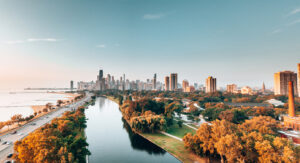Chicago Road Safety Overview

With around 2.7 million residents, Chicago is the third-most-populated city in the U.S. The millions of citizens help contribute to the city’s diversity and rich culture, but they also contribute to the high number of serious and fatal car accidents in Chicago.
While Chicago has a way to go before its roads are entirely free of accidents, the city boasts several programs that are helping reduce the crash rate. Taking a closer look at how and why crashes happen on Chicago city streets is an important first step toward making Chicago’s roads safer for locals and visitors alike.
Chicago Car Accident Statistics: An Overview
According to data from the Illinois Department of Transportation, Cook County saw 399 fatal car accidents in 2022. This number showed a slight reduction from the previous year, which saw a total of 456. While the decrease in deadly crashes is a good sign, statewide data still casts a grim picture.
Cook County crashes — the majority of which occur in and around the congested metropolitan streets of Chicago — account for about half of the state’s fatal crashes each year. This means that reducing Chicago’s crash rate helps to increase the overall road safety rate for the entire state of Illinois.
Data from the City of Chicago offers a glimpse into when and how Chicago accidents most commonly occur.
In the most recent year reported:
- Chicago saw an annual total of 658,000 car accidents
- Chicago saw an average of 8,000-10,000 crashes each month
- The fewest crashes happened in February, with a total of 7,963
- The greatest number of crashes happened in May, with a total of 10,100
- 59,000 crashes resulted in a non-incapacitating injury
- 13,100 crashes resulted in an incapacitating injury
Understanding why these crashes occur is an essential first step for targeting the causal factors and helping reduce the number of injuries and deaths on Chicago city streets each year.
Taking a Closer Look At When Crashes Occur in Chicago, IL
People often associate car accidents with highways. When a crash occurs at high speeds, it’s more likely to produce dangerous or deadly outcomes. Bad weather and nighttime driving are also commonly thought to increase the risk of an accident.
However, much of Chicago’s annual crash data paints a different picture.
According to Chicago police reports made available through City of Chicago data:
- For 562,000 crashes, the posted area speed limit was 30-35 miles an hour
- Saturday is the day of the week with the highest Chicago crash rate
- The time of day with the highest accident rate is between 3 p.m. and 5 p.m.
- Most accidents (603,000) happen in clear weather
- Most accidents (493,000) happen during daylight hours
These statistics show that most Chicago accidents happen in broad daylight, in clear weather, and on streets where drivers shouldn’t be traveling any faster than 35 mph.
Common Reasons For Chicago Car Accidents
In Chicago and across the country, car accidents are generally caused by the same group of behaviors. While some accidents might result from mechanical issues or other factors outside the driver’s control, most crashes stem from human error.
Some of the leading causes of Chicago accidents include:
Encouraging all drivers to follow driving rules and give their full attention to the road and the vehicles around them can help significantly reduce the number of serious accidents in Chicago each year.
Programs Helping Reduce the Car Accident Rate in Chicago, IL
Car accidents that result in injury and death affect the finances and quality of life of the victims and their loved ones. In addition to the emotional impact and financial costs of accidents, Chicago crashes have a domino effect, straining city resources, slowing down traffic, and increasing the risk of additional accidents.
The City of Chicago has multiple programs designed to help reduce the city’s crash rate. Each of these programs has a unique objective for making Chicago’s streets a safer place.
Vision Zero Chicago
Vision Zero Chicago is the Chicago’s leading program designed to reduce the overall rate of fatal car accidents. The program takes the stance that Chicago accidents are unacceptable, preventable, and a shared community responsibility.
It actively works to reduce Chicago’s crash rate by:
- Viewing crashes as a public health issue
- Designing streets and setting speed limits to increase safety
- Taking an educational stance on policing traffic laws
- Equitably investing resources
- Implementing action plans both city-wide and for high-crash areas
As the city continues to assess and adjust its Vision Zero Chicago action plans, the hope is that Chicago’s crash rate will decline considerably.
Chicago’s Red Light Enforcement Program
Chicago’s Red Light Camera Enforcement Program has already made a significant dent in the rate of intersection accidents that occur across the city. The program was rolled out in 2003 and has expanded from just two intersection cameras to 149 cameras spread across the greater Chicago area.
Chicago’s data on intersection crashes shows that the crash rate for intersection accidents has dropped significantly across the city in places where red light enforcement cameras are in use.
Chicago’s SAFE Ambassadors
SAFE Ambassadors is the public outreach program of the Chicago Department of Transportation (CDOT). The program is designed to help reduce the number of car crashes in Chicago. SAFE Ambassadors help spread awareness of basic traffic safety, emphasizing cyclist and pedestrian safety.
The public outreach program conducts safety presentations in schools throughout the city, passing out safety literature and conducting bicycle safety classes for children and adults.
Planning For a Safer Future on Chicago Roads
Making Chicago roads a safer place requires the participation of every driver, pedestrian, and cyclist in the city. Taking the time to review basic driving laws, never driving while drowsy or under the influence, and giving your full attention to the roads and traffic around you is how every Chicagoan can help reduce the rate of car accidents on Chicago city streets.
